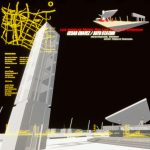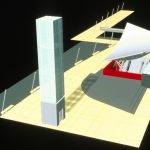- Cezar Chaves
M E T R O P O L I T A N T R A N S P O R T A T I O N A U T H O R I T Y P R O J E C T M e t r o R e d L i n e, Los Angeles, California, 1996
Commissioner: Metropolitan Transportation Authority
Architect: Meherdad Yazdani, Dworsky Associates
Budget: $ 350,000 Throughout history, public squares and plazas have been regarded as extremely important loci of culture. Located in the heart of Boyle Heights in Los Angeles, California, the goal for Cesar Chavez/Soto Station was to create a plaza or communal space for the multi-generational communities of the area, while acknowledging the historical importance of East L.A. as a landing place for people from diverse ethnic backgrounds. The plaza was conceived as a town square, a place where people are encouraged to participate in urban activities.
Three elements activate the center of the plaza:
1. An urban stage, or raised area, that can be used for performances or as a gathering place, and at the same time provides seating.
2. A canopy that affords shelter for rail patrons, defines a protected bus stop, serves as a backdrop for the urban stage, and visually marks the entry to the station.
3. A tall glass structure that signifies the location of the station and functions as a light tower after dark.
Light, being an important part of celebration and ritual for local communities, is used as a metaphor for congregation and as a beacon, symbolizing the safe end of a journey. The interior of the station is a spatially sculpted grand room that echoes, through bright color, the vitality of surrounding neighborhoods. Red terrazzo tile is used on the mezzanine and at the entrance to the station.
Emphasizing the rich multi-cultural history of the past, the colorful graphic images throughout the interior of the station represent universal images of human potential—expressing dreams, hopes, and aspirations, and celebrating the future of the community. The text on columns and stair risers evokes questions about the past and future, as well as personal histories and memories. By probing shifting cultural perspectives, the intent is to provoke questions and revise our thinking in the new context of multiculturalism.



